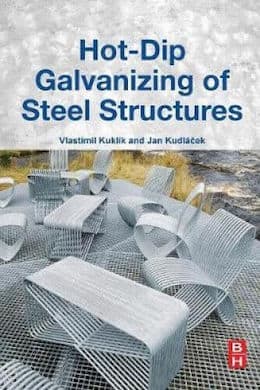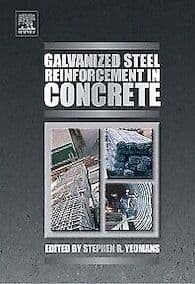
-----
Contamination of galvanizing flux
for Engineers, Shops, Specifiers

avail from eBay, AbeBooks, or Amazon

avail from eBay, AbeBooks, or Amazon

avail from eBay, AbeBooks, or Amazon

avail from eBay, AbeBooks, or Amazon
avail from Amazon
"User's Guide to Hot Dip Galvanizing for Corrosion Protection in Atmospheric Service" by NACE (1997 only rarely avail.)
avail from AbeBooks, or Amazon
(as an Amazon Associate & eBay Partner, we earn from qualifying purchases)
Q. Sir,
we are using hot dip galvanisation process and flux getting contaminated with HCl and Iron and its color becomes redish. previously we are using Ammonium water for filtration now - a- days work load is too high so we are mixing ammonium water to it.
Can you suggest me what can I do to avoid this problem without affecting workload?
telecom network solutions - Noida, U.P., India
April 25, 2008
A. Sir:
The red-ish color of the flux is iron (+3) hydroxide (e.g.
Fe(OH)3 which is insoluble at the normal pH of flux which is 4.2. Likely you have substantial quantities of this red-ish solid in the bottom of your flux tank which you must decant off the flux solution and clean out the flux tank (the red-ish solid). More important is the soluble iron which is Fe+2 which is fully soluble at the normal pH of flux. This iron +2 has a slight green color to it. What is your iron
+2 concentration (either percent or g/liter basis)? Do you have testing methods for iron +2 in you flux? Titrant would be permanganate (self indicating) or dichromate (with an indicator). Dichromate is much better because it is much more stable. Do you have means to test the pH of your flux? pH paper or a pH meter do not work. What is the density of your flux solution (either baumé units or g/ml)?
Which acid do you use to pickle with? I suspect it is HCl. How many rinse tanks do you have between the HCl and flux tank?
Where is Noida? I worked for Tata in Jamshedpur and Apollo Tubes in the South. India is an interesting country.
Regards,
Galvanizing Consultant - Hot Springs, South Dakota, USA
Q. Sir,
Noida is situated in between New Delhi and Gaziabad. it is newly developed industrial belt in UP or near capital region.
We are checking pH by pH meter generally it is in between 2.4 to 5.2 and Specific gravity by hydrometer is 1.17 to 2.00
We how can we calculate gm/ltr calculation can you suggest.
With best regards,
- Noida, UP, India
May 21, 2008
A. Sir:
A pH meter cannot be used in hot dip galvanizing flux because the flux is too concentrated and the probe gets "poisoned." Proper pH for flux is 4.2 with a plus/minus of about 0.2 pH units. A specific gravity of 1.17g/L corresponds to a baumé of 21.07. A specific gravity of 2.00g/L corresponds to a baumé of 72.5. This last baumé
(e.g. 72.5) is not possible. The baumé of a galvanizing flux measured at room temperature would be in the range of about 12 to about 40 degrees baumé units depending on its composition and purpose. To change from density in grams/Liter to degrees baumé units simply multiply the density by 145, then subtract 145 from that result and then divide by the original density. The Handbook of Chemistry and Physics has a conversion chart for density and baumé.'
Your flux supplier should have a density or baumé chart for each type of flux that they sell that gives the grams/Liter for a specific type of flux. Are you using double salt, triple salt, or quadraflux?
You seem to be new to galvanizing. To make matters more difficult, I have found several Indian fluxes to contain sodium chloride and/or potassium chloride which usually gives poor results.
One flux used in India was made from fertilizer grade ammonium chloride and technical grade zinc chloride. This flux with a suitable wetting agent at 0.03% was doing an excellent job for galvanizing.
Regards,
Galvanizing Consultant - Hot Springs, South Dakota, USA
Q, A, or Comment on THIS thread -or- Start a NEW Thread
